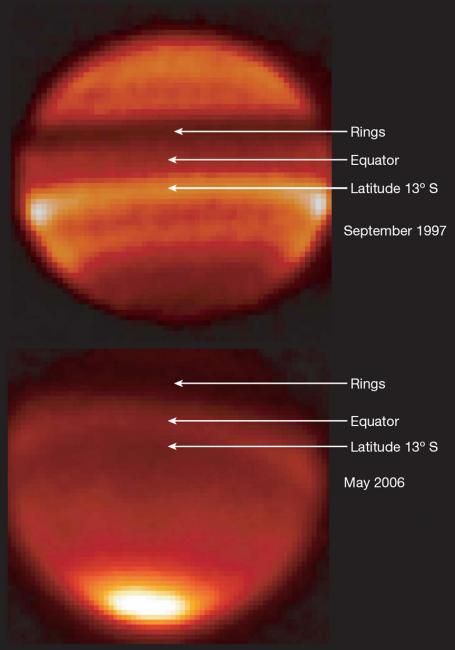
Two images of Saturn in the thermal infrared taken 13 months apart show evidence for climatic change. The top image shows bright bands of emission due to methane in Saturn's atmosphere; the lower image shows that the emission has faded (due to colder temperatures).
The Earth is not the only planet whose atmosphere experiences seasonal weather changes. Optical observations of planets in our outer solar solar system, (Jupiter and Saturn, for example) cannot detect such changes very easily, however, because their atmospheres are cold (about 126 kelvin, or -147 degrees Celsius). At these low temperatures, infrared observations are better suited to probe the atmospheric molecules that reveal the frigid local conditions.
SAO astronomer Joe Hora is a member of an international team of 28 astronomers that has been studying Saturn's atmosphere for twenty-seven years -- during nearly one complete 29.4 year period of Saturn's orbit of the sun. Using infrared cameras to monitor the emission from methane and ethane in Saturn's atmosphere, the astronomers found that brightening and dimming occurred 14.8 earth-years apart, in apparent correspondence with Saturn's half-period. Writing in this week's Nature, the team reports that the change in temperature corresponding to this effect is modest, about 6 degrees. In Jupiter and Saturn, altitudes are measured in atmospheric pressure rather than kilometers. The newly temperatures changes are taking place at a height where the pressure is about one-fiftieth of the pressure at ground level on earth, and on earth that pressure occurs at an altitude about twenty-five kilometers above the surface.
The scientists speculate that these variations are consistent with vertical and meridional temperature changes in the atmosphere, like those that occur in the Earth's atmosphere as a result of seasonal oscillations. Although similar seasonal variations have been identified in Jupiter's atmosphere, this is the first time such seasonal changes have been seen in Saturn. The authors note that, pending further modeling still to be done, the physical processes responsible -- east-west winds and lower-to-upper atmosphere airflows -- may be common to the atmospheric transport mechanism in all of the planets. If so, then these and similar studies of other planets will help shed light on how the Earth's atmosphere responds to seasonal changes, and thereby help to refine the models of planetary atmosphere.